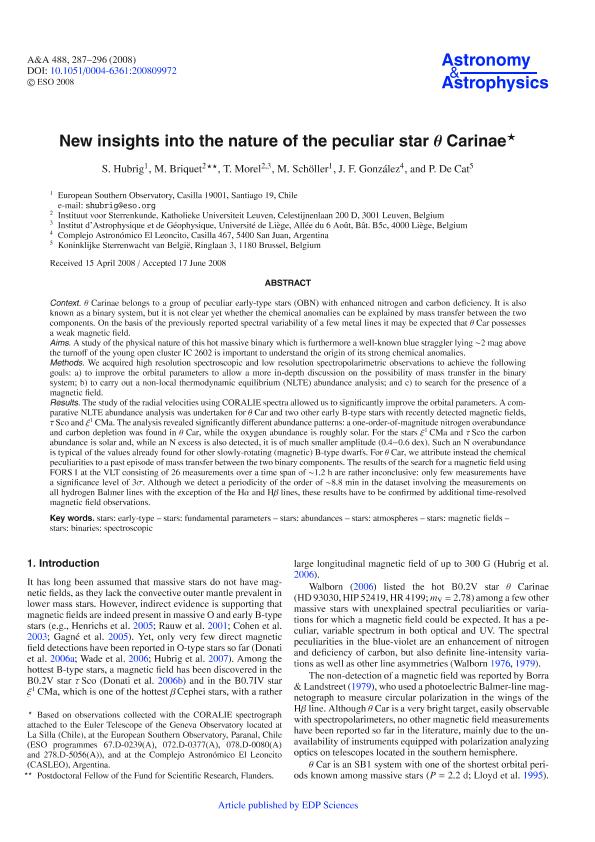Mostrar el registro sencillo del ítem
dc.contributor.author
Hubrig, S.
dc.contributor.author
Briquet, M.
dc.contributor.author
Morel, T.
dc.contributor.author
Schöller, M.
dc.contributor.author
Gonzalez, Jorge Federico

dc.contributor.author
De Cat, P.
dc.date.available
2023-10-11T15:59:18Z
dc.date.issued
2008-12
dc.identifier.citation
Hubrig, S.; Briquet, M.; Morel, T.; Schöller, M.; Gonzalez, Jorge Federico; et al.; New insights into the nature of the peculiar star θ Carinae; EDP Sciences; Astronomy and Astrophysics; 488; 1; 12-2008; 287-296
dc.identifier.issn
0004-6361
dc.identifier.uri
http://hdl.handle.net/11336/214862
dc.description.abstract
θ Context. Carinae belongs to a group of peculiar early-type stars (OBN) with enhanced nitrogen and carbon deficiency. It is also known as a binary system, but it is not clear yet whether the chemical anomalies can be explained by mass transfer between the two components. On the basis of the previously reported spectral variability of a few metal lines it may be expected that Car possesses a weak magnetic field.Aims. A study of the physical nature of this hot massive binary which is furthermore a well-known blue straggler lying ~2 mag above the turnoff of the young open cluster IC 2602 is important to understand the origin of its strong chemical anomalies.Methods. We acquired high resolution spectroscopic and low resolution spectropolarimetric observations to achieve the following goals: a) to improve the orbital parameters to allow a more in-depth discussion on the possibility of mass transfer in the binary system; b) to carry out a non-local thermodynamic equilibrium (NLTE) abundance analysis; and c) to search for the presence of a magnetic field. Results. The study of the radial velocities using CORALIE spectra allowed us to significantly improve the orbital parameters. A comparative NLTE abundance analysis was undertaken for Car and two other early B-type stars with recently detected magnetic fields, τ Sco and ξ1 CMa. The analysis revealed significantly different abundance patterns: a one-order-of-magnitude nitrogen overabundance and carbon depletion was found in Car, while the oxygen abundance is roughly solar. For the stars ξ1 CMa and τ Sco the carbon abundance is solar and, while an N excess is also detected, it is of much smaller amplitude (0.4-0.6 dex). Such an N overabundance is typical of the values already found for other slowly-rotating (magnetic) B-type dwarfs. For Car, we attribute instead the chemical peculiarities to a past episode of mass transfer between the two binary components. The results of the search for a magnetic field using FORS 1 at the VLT consisting of 26 measurements over a time span of ~1.2 h are rather inconclusive: only few measurements have a significance level of 3. Although we detect a periodicity of the order of ~8.8 min in the dataset involving the measurements on all hydrogen Balmer lines with the exception of the Hα and H lines, these results have to be confirmed by additional time-resolved magnetic field observations.
dc.format
application/pdf
dc.language.iso
eng
dc.publisher
EDP Sciences

dc.rights
info:eu-repo/semantics/openAccess
dc.rights.uri
https://creativecommons.org/licenses/by-nc-sa/2.5/ar/
dc.subject
STARS: ABUNDANCES
dc.subject
STARS: ATMOSPHERES
dc.subject
STARS: BINARIES: SPECTROSCOPIC
dc.subject
STARS: EARLY-TYPE
dc.subject
STARS: FUNDAMENTAL PARAMETERS
dc.subject
STARS: MAGNETIC FIELDS
dc.subject.classification
Astronomía

dc.subject.classification
Ciencias Físicas

dc.subject.classification
CIENCIAS NATURALES Y EXACTAS

dc.title
New insights into the nature of the peculiar star θ Carinae
dc.type
info:eu-repo/semantics/article
dc.type
info:ar-repo/semantics/artículo
dc.type
info:eu-repo/semantics/publishedVersion
dc.date.updated
2023-07-07T20:32:51Z
dc.journal.volume
488
dc.journal.number
1
dc.journal.pagination
287-296
dc.journal.pais
Francia

dc.journal.ciudad
Paris
dc.description.fil
Fil: Hubrig, S.. European Southern Observatory Chile; Chile
dc.description.fil
Fil: Briquet, M.. Katholieke Universiteit Leuven; Bélgica
dc.description.fil
Fil: Morel, T.. Katholieke Universiteit Leuven; Bélgica. Université de Liège; Bélgica
dc.description.fil
Fil: Schöller, M.. European Southern Observatory Chile; Chile
dc.description.fil
Fil: Gonzalez, Jorge Federico. Consejo Nacional de Investigaciones Científicas y Técnicas. Centro Científico Tecnológico Conicet - San Juan. Instituto de Ciencias Astronómicas, de la Tierra y del Espacio. Universidad Nacional de San Juan. Instituto de Ciencias Astronómicas, de la Tierra y del Espacio; Argentina. Consejo Nacional de Investigaciones Científicas y Técnicas. Centro Científico Tecnológico Conicet - San Juan. Complejo Astronómico "El Leoncito". Universidad Nacional de Córdoba. Complejo Astronómico "El Leoncito". Universidad Nacional de la Plata. Complejo Astronómico "El Leoncito". Universidad Nacional de San Juan. Complejo Astronómico "El Leoncito"; Argentina
dc.description.fil
Fil: De Cat, P.. Koninklijke Sterrenwacht van België; Bélgica
dc.journal.title
Astronomy and Astrophysics

dc.relation.alternativeid
info:eu-repo/semantics/altIdentifier/doi/http://dx.doi.org/10.1051/0004-6361:200809972
dc.relation.alternativeid
info:eu-repo/semantics/altIdentifier/url/https://www.aanda.org/articles/aa/abs/2008/34/aa09972-08/aa09972-08.html
Archivos asociados
